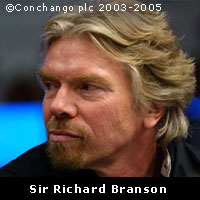Branson offers USD 25 million prize to fight climate change
A prize of USD 25 million (EUR19.2 million) is on offer to any individual or group able to come up with a commercially viable system for the removal of greenhouses gases. Launched on 9 February by Sir Richard Branson, Head of UK Virgin Group, the Virgin Earth Challenge will initially run for five years. It will aim to encourage scientists from around the world to compete to find a solution to remove at least 1 billion tonnes of carbon dioxide (CO2) per year from the Earth's atmosphere. Entries should 'demonstrate a commercially viable design which will result in the net removal of anthropogenic, atmospheric greenhouse gases each year for at least 10 years without countervailing harmful effects. This removal must have long term effects and contribute materially to the stability of the Earth's climate,' reads a press release from the Virgin Group. According to the recent findings of the Intergovernmental Panel on Climate Changes, temperatures on Earth could increase by as much as 6.4°C by the end of this Century. There is a growing consensus among scientists that global warming is a result of human-generated carbon dioxide and other greenhouse gases. 'It is our hope and belief that the winner of The Virgin Earth Challenge will help to reverse the collision course our beautiful world is currently on. They will not only make history but preserve history for many, many generations to come,' said Sir Richard at the launch of the prize. 'However, it is important to remember that there is a real possibility that no one will win this prize. Governments, and their people, must continue to use every effort to radically reduce CO2 emissions,' he underlined. Entries will be judged by a panel of scientists, environmental experts and campaigners including, among others, former US vice-president Al Gore, director of NASA's Institute for Space Studies James Hansen, and creator of the Gaia theory James Lovelock. The judges will meet annually to determine whether a design has been submitted during the previous year that, in their view, should win the prize. If such a design has been received, they may award the prize without waiting for the five year period to elapse. If no winner has been selected at the end of five years, the judges may decide to roll the prize forward for a further period.



